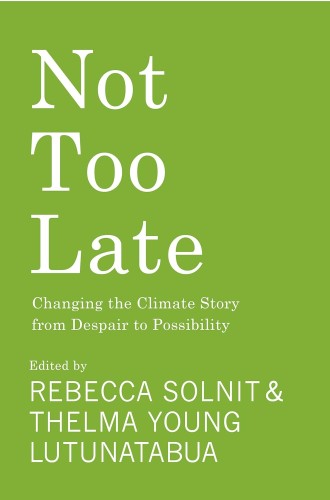Stories of hope amid the climate crisis
In this edited volume, the focus is on actions that have yielded significant results.
Not Too Late derives its title from a website and resource collection created by the book’s two editors. One of the two, Rebecca Solnit, writes frequently on feminism, politics, and the environment. The other, Thelma Young Lutunatabua, is a resident of Fiji and Texas who has publicized the risks faced by Pacific island nations due to climate change. This collection of essays, Solnit writes, arose from a “wonderful gathering of old and new friends in March 2022,” at which, “when I told them I’d stopped writing books to try to be a better climate activist and told them about Not Too Late, they, in unison, told me to turn it into a book, so we did.”
Short essays by 20 academics and activists (interspersed with additional chapters by the editors) recount climate crisis initiatives in North and South America, South Asia, the Pacific islands, and Australia. The focus is on actions that yielded significant results, sometimes by blocking risky energy and development projects, sometimes by broadening public awareness.
The dangers to communities and populations in Pacific atolls are recounted by Fenton Lutunatabua and Joseph Zane Sikulu of the Pacific Climate Warriors, a youth organization affiliated with the global 350.org network. As rising ocean levels threaten to inundate coastal settlements, activists have planted mangroves to stabilize estuaries, assisted in relocation plans, and prepared agricultural land farther inland, while seeking international attention and assistance. The Warriors’ motto: “We’re not drowning, we’re fighting.”
The 2022 report of the Intergovernmental Panel on Climate Change was widely perceived as a prophecy of “climate chaos” due to rising temperatures and collapsing economies. One of its authors, Edward Carr, writes that, on the contrary, the report pointed to clear pathways to a climate-resilient future for everyone by connecting actions that reduce greenhouse-gas emissions (called climate change mitigation), manage the impacts of climate change we can no longer avoid (climate change adaptation), and promote a sustainable future of decent living standards and opportunity for all (sustainable development).
Effective local action, he says, coupled with political accountability and regional coordination, “produces solutions tailored to specific opportunities and needs that can aggregate up to global impacts.”
This tone of hope, tempered as it must be by the realities of global politics and economics, pervades the collection. “We Have the Solutions” proclaims the first section heading, followed by “Frameworks of Possibility” and “The Future We Want.” Several writers highlight the legacy of colonialism as an impediment to building sustainable economies, turning to indigenous traditions of Asia and the Pacific for a holistic understanding of the human and the natural world. Apart from these references, and a few passing allusions to Buddhist teachings, religious traditions are absent from the essays, neither blamed for callousness toward the environment nor credited with motivating restorative action.
In an essay entitled “How the Ants Moved the Elephants in Paris,” Filipino climate activist Renato Redentor Constantino recalls the 2015 United Nations Climate Change Conference, at which the developed nations nearly succeeded in moving the global warming target of 1.5 degrees Celsius, as recommended by climate scientists, to the less ambitious threshold of 2 degrees. Members of the Climate Vulnerable Forum, a coalition of less-developed nations from several continents, argued persistently for the lower limit, observing that they had contributed little to pollution but were already suffering from its effects. Their arguments were heard, and the lower limit was enshrined in the Paris Agreement, legally binding on all the signatories. Thus can ants move elephants.
Inserted between two of the book’s sections is “An Extremely Incomplete List of Climate Victories,” beginning in the 1970s. Among the events listed are movements that blocked deforestation in Brazil and India, adoption of vehicle emissions limits in California and then nationally, building a Great Green Wall to slow desertification in the Sahel, and cancellation of new pipelines across Native American lands. Last on the list is the 2022 Inflation Reduction Act, which set new standards and offered incentives for clean energy.
Many of the local initiatives highlighted by contributors are highly context-specific and would be difficult to replicate. The collection is not so much a handbook for activists as a source of encouragement and perspective. It is easy to sink into despair, writes New York activist Yotam Marom in an essay titled “What to Do When the World Is Ending.” But “despair is the easy way out,” he counters—and “despair is also, quite simply, bad politics,” because it focuses our attention on ourselves and tempts us to lapse into the “politics of powerlessness.”
One of the five essays Solnit contributes to the book, “In Praise of Indirect Consequences,” sums up the lessons of the book succinctly. A sustainable future, she suggests, is no longer a set of goals to achieve but has become “how we think about renewables, jobs, climate, and justice.” Social movements, she observes, hardly ever win, in the sense of achieving all their goals. All the same, they move both society and discourse forward by changing the terms in which we see the present and the future. She makes an analogy with visual art: “A moderately successful artist is recognizable and visible, but a truly impactful artist is no longer what you see but how you see. They have become invisible because they are behind your eyes rather than in front of them.”





